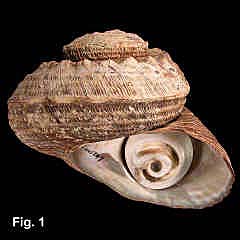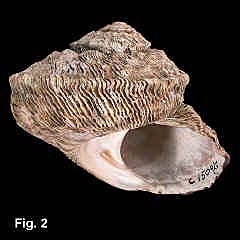|
|
|
|
|
Turbo (Ninella) torquatus Gmelin, 1791 Description: Shell large, solid and heavy, with width greater than height. Early whorls angled with sutures channelled, later whorls more rounded. Body whorl sculptured with about 10 spiral ribs, crossed by thin, erect, dense axial lamellae; spiral row of weak nodules below suture. Umbilicus widely open; columella and umbilicus white; interior nacreous with external ribbing showing through. Outer lip thin, simple. Colour pale brown, sometimes mottled with green or orange in juvenile shells. Operculum calcareous, white, surface minutely pustulate, strongly spirally ribbed with deep depression on exterior surface. Size: Up to 110 mm wide, 98 mm high. Distribution: Endemic to Australia with an eastern and a southern population. In the east it occurs from Brunswick Heads to Green Cape, NSW, and in the south from eastern SA to Port Gregory, WA. The range was apparently continuous in the recent geological past, as the species occurs in good condition, sometimes with the operculum in place, in quaternary fossil beds in Victoria (Macpherson and Gabriel, 1962). Habitat: On exposed rocky shores, in the lower littoral and the sublittoral. Common. Remarks: The West Australian population has been described as subspecies whitleyi Iredale, 1949. Compared with the eastern form it has an angulate body whorl (Fig. 2) and the sutural channel and row of nodules below are more pronounced. South Australian specimens are closer in form to eastern shells, but there is intergrading between the two forms. Fig. 1: Nelson Bay, NSW (C.445847) Fig. 2: Geraldton, WA (C.150920) |

